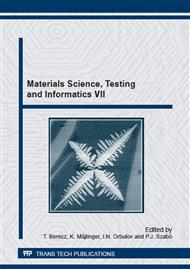p.125
p.131
p.137
p.143
p.149
p.155
p.161
p.167
p.173
Role of the Physical Simulation for the Estimation of the Weldability of High Strength Steels and Aluminum Alloys
Abstract:
The physical simulation is an ultimate innovative way to develop the welding processes. The paper introduces the connection between weldability and physical simulation, hot-cracking sensibility, the Gleeble 3500 thermo-mechanical physical simulator, respectively. Four kinds of materials were investigated and different kinds of physical simulation test methods were made such as, identification of the Nil-Strength Temperature (NST), hot tensile tests (on heating and on cooling parts of the welding simulation curve are also investigated). Furthermore, Heat Affected Zone (HAZ) tests are being introduced. The future approaches of the research are also exposed.
Info:
Periodical:
Pages:
149-154
Citation:
Online since:
February 2015
Authors:
Price:
Сopyright:
© 2015 Trans Tech Publications Ltd. All Rights Reserved
Share:
Citation:


